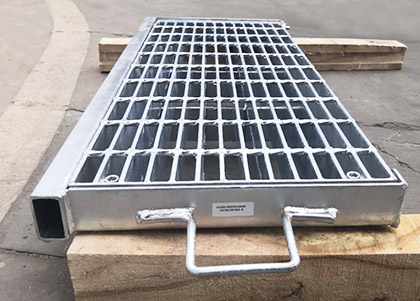When it comes to the load capacity of trench covers, it is essential to consider the material and design of the cover. The load capacity refers to the maximum weight that the trench cover can withstand without deforming or breaking. This is a crucial factor in ensuring safety and durability in various applications.
One of the most common materials used for trench covers is ductile iron. Ductile iron trench covers are known for their high load capacity, making them suitable for heavy-duty applications such as roadways, ਹਵਾਈ ਅੱਡੇ, and industrial facilities. The load capacity of ductile iron trench covers can range from 10,000 ਸਾਦੇ ਜ serrated ਸਤਹ ਦੇ ਨਾਲ ਅਤੇ ਸਤਹ ਇਲਾਜ galvanized ਜ ਇਲਾਜ ਕੀਤਾ ਜਾ ਸਕਦਾ ਹੈ 40,000 pounds, depending on the size and thickness of the cover.

Another popular material for trench covers is composite materials, such as fiberglass and reinforced plastics. These materials offer a good balance of strength and lightweight properties. The load capacity of composite trench covers can vary widely, ranging from 5,000 ਸਾਦੇ ਜ serrated ਸਤਹ ਦੇ ਨਾਲ ਅਤੇ ਸਤਹ ਇਲਾਜ galvanized ਜ ਇਲਾਜ ਕੀਤਾ ਜਾ ਸਕਦਾ ਹੈ 20,000 pounds. It’s important to consult the manufacturer’s specifications to determine the exact load capacity of a specific composite trench cover.
In addition to the material, the design of the trench cover also plays a significant role in determining its load capacity. Trench covers with a solid plate design tend to have higher load capacities compared to those with an open grating design. The solid plate design distributes the weight more evenly, allowing for greater load-bearing capabilities.
When evaluating the load capacity of trench covers, it’s crucial to consider the anticipated traffic loads in the area where the covers will be installed. For example, trench covers in pedestrian areas may have different load capacity requirements compared to covers in vehicle traffic areas. It’s important to assess the specific load requirements and select trench covers that meet or exceed those requirements.

The load capacity of trench covers is typically tested and rated according to industry standards, such as the American Association of State Highway and Transportation Officials (AASHTO) or the EN124 standard in Europe. These standards provide guidelines for testing the load capacity of trench covers under various conditions, ensuring that they can withstand the expected loads in real-world applications.
In conclusion, the load capacity of trench covers is a critical consideration in ensuring safety and performance in infrastructure applications. By understanding the materials, design, and industry standards related to load capacity, it’s possible to select the most suitable trench covers for specific needs. Whether it’s ductile iron, composite materials, or other options, there are various choices available to meet different load capacity requirements.

